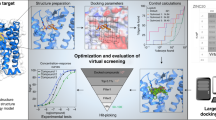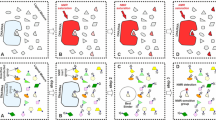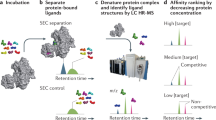Key Points
-
NMR has become a valuable screening tool for analysing the binding of ligands to protein targets. Furthermore, NMR can provide structural information on protein–ligand interactions to aid in the optimization of weak-binding hits into high-affinity leads.
-
Methods for detecting binding fall into two main categories: those that monitor NMR signals from the ligand and those that monitor NMR signals from the protein.
-
Experiments that monitor the ligand exploit the large differences in the rates of rotational and translational motions of a small molecule in the free state relative to when it is bound to a macromolecules. The consequent effects on NMR properties, such as transverse and longitudinal relaxation times, are indicative of ligand binding.
-
Experiments that monitor the ligand have the advantages of requiring only small quantities of unlabelled protein, and also allowing several compounds to be studied simultaneously.
-
Experiments that monitor the protein, such as chemical-shift mapping, usually require labelled protein. However, coupled with resonance assignments, they can provide valuable information on the location of binding sites and the nature of the interactions that is not given by experiments that monitor the ligand.
-
In SAR by NMR, ligand binding is detected by chemical-shift mapping using a labelled protein target. In this way, small molecules that bind to two distinct sites on the protein are identified. Structural information on the binding modes and site positions is then used to aid the discovery of high-affinity compounds in which the two small-molecule fragments are linked.
-
SHAPES is a strategy in which ligand binding is assessed by observing signals from the ligand. Hits from a screen of a fairly small but diverse library of low-molecular weight scaffolds against an unlabelled protein target are optimized into high-affinity compounds by iterative synthetic modification and re-screening.
-
NMR-SOLVE exploits the fact that large families of proteins have adjacent binding sites, one of which is conserved throughout the family. It uses selective labelling of residues around the conserved binding site to guide the synthesis of high-affinity bi-ligand inhibitors, one part of which binds in the conserved binding site, and the other which binds in the adjacent site to give specificity.
Abstract
NMR spectroscopy has evolved into an important technique in support of structure-based drug design. Here, we survey the principles that enable NMR to provide information on the nature of molecular interactions and, on this basis, we discuss current NMR-based strategies that can identify weak-binding compounds and aid their development into potent, drug-like inhibitors for use as lead compounds in drug discovery.
This is a preview of subscription content, access via your institution
Access options
Subscribe to this journal
Receive 12 print issues and online access
$209.00 per year
only $17.42 per issue
Buy this article
- Purchase on Springer Link
- Instant access to full article PDF
Prices may be subject to local taxes which are calculated during checkout





Similar content being viewed by others
References
Wüthrich, K. NMR of Proteins and Nucleic Acids. (Wiley, New York, 1986).
Pellecchia, M. et al. NMR-based structural characterization of large protein–ligand interactions. J. Biomol. NMR 22, 165–173 (2002).This paper describes the NMR-SOLVE method, which allows, with a suitable suite of NMR experiments and selective isotope-labelling schemes, the rapid structural characterization of ligand interactions with proteins of molecular masses up to 200 kDa.
Medek, A., Hajduk, P. J., Mack, J. & Fesik, S. W. The use of differential chemical shift for determining the binding site location and orientation of protein-bound ligands. J. Am. Chem. Soc. 122, 1241–1242 (2000).
Abragam, A. Principles of Nuclear Magnetism (Oxford Univ. Press, New York, 1961).
Neuhaus, D. & Williamson, M. P. The Nuclear Overhauser Effect in Structural and Conformational Analysis. (Wiley–VCH, New York, 2000).
Kumar, A., Ernst, R. R. & Wüthrich, K. A two-dimensional nuclear Overhauser enhancement (2D NOE) experiment for the elucidation of complete proton–proton cross-relaxation networks in biological macromolecules. Biochem. Biophys. Res. Commun. 95, 1–6 (1980).
Hajduk, P. J., Olejniczak, E. T. & Fesik, S. W. One-dimensional relaxation- and diffusion-edited NMR methods for screening compounds that bind to macromolecules. J. Am. Chem. Soc. 119, 12257–12261 (1997).
Jahnke, W., Rüdisser, S. & Zurini, M. Spin label enhanced NMR screening. J. Am. Chem. Soc. 123, 3149–3150 (2001).
Ni, F. Recent developments in transferred NOE methods. Prog. NMR Spectrosc. 26, 517–606 (1994).
Mayer, M. & Meyer, B. Characterization of ligand binding by saturation transfer difference NMR spectroscopy. Angew. Chem. Int. Edn Engl. 38, 1784–1788 (1999).
Klein, J., Meinecke, R., Mayer, M. & Meyer, B. Detecting binding affinity to immobilized receptor proteins in compound libraries by HR-MAS STD NMR. J. Am. Chem. Soc. 121, 5336–5337 (1999).
Chen, A. & Shapiro, M. J. NOE pumping: a novel NMR technique for identification of compounds with binding affinity to macromolecules. J. Am. Chem. Soc. 120, 10258–10259 (1998).
Chen, A., & Shapiro, M. J. NOE pumping. 2. A high-throughput method to determine compounds with binding affinity to macromolecules by NMR. J. Am. Chem. Soc. 122, 414–415 (2000).
Dalvit, C. et al. Identification of compounds with binding affinity to proteins via magnetization transfer from bulk water. J. Biomol. NMR 18, 65–68 (2000).
Gibbs, S. J. & Johnson, C. S. A PFG-NMR experiment for accurate diffusion and flow studies in the presence of Eddy currents. J. Magn. Reson. 93, 395–402 (1991).
Altieri, A. S., Hinton, D. P. & Byrd, R. A. Association of biomolecular systems via pulse-field gradient NMR self-diffusion measurements. J. Am. Chem. Soc. 117, 7566–7567 (1995).
Shuker, S. B., Hajduk, P. J., Meadows, R. P. & Fesik, S. W. Discovering high-affinity ligands for proteins: SAR by NMR. Science 274, 1531–1534 (1996).A structure-based drug design strategy that uses NMR to design bi-ligand inhibitors that are specific for a given target. Relies initially on the complete structural characterization of protein–ligand complexes.
Hajduk, P. J. et al. NMR-based discovery of lead inhibitors that block DNA-binding of the human papillomavirus protein E2 protein. J. Med. Chem. 40, 3144–3150 (1997).
Hajduk, P. J. et al. Discovery of potent non-peptide inhibitors of stromelysin using SAR by NMR. J. Am. Chem. Soc. 119, 5818–5827 (1997).
Hajduk, P. J. et al. Novel inhibitors of Erm methyltransferases from NMR and parallel synthesis. J. Med. Chem. 42, 3852–3859 (1999).
Boehm, H. J. et al. Novel inhibitors of DNA girase: 3D structure based biased needle screening, hit validation by biophysical methods and 3D guided optimization. A promising alternative to random screening. J. Med. Chem. 43, 2664–2674 (2000).
Ross, A. & Senn, H. Automation of measurements and data evaluation in biomolecular NMR screening. Drug Discov. Today 6, 583–593 (2001).
Hajduk, P. J. et al. High-throughput nuclear magnetic resonance-based screening. J. Med. Chem. 42, 2315–2317 (1999).
Fejzo, J. et al. The SHAPES strategy: an NMR-based approach for lead generation in drug discovery. Chem. Biol. 6, 755–769 (1999).A drug design strategy that is based on the use of a library of low-molecular-mass fragments collected from the statistical analysis of established drugs. Protein targets are screened against weakly binding, drug-like molecular fragments, and hits are used to construct drug candidates computationally or in the laboratory.
Bemis, G. W. & Murcko, M. A. The properties of known drugs. 1. Molecular frameworks J. Med. Chem. 39, 2887–2893 (1996).
Hajduk, P. J. et al. NMR-based screening of proteins containing 13C-labeled methyl groups, J. Am. Chem. Soc. 122, 7898–7904 (2000).
Wüthrich, K. NMR in Structural Biology (World Scientific, Singapore, 1995).
Li, D. W., DeRose, E. F. & London, R. E. The inter-ligand Overhauser effect: a powerful new NMR approach for mapping structural relationships of macromolecular ligands. J. Biomol. NMR 15, 71–76 (1999).
London, R. E. Theoretical analysis of the inter-ligand Overhauser effect: a new approach for mapping structural relationships of macromolecular ligands. J. Magn. Reson. 141, 301–311 (1999).
Jahnke, W. et al. Second-site NMR screening with a spin-labeled first ligand. J. Am. Chem. Soc. 122, 7394–7395 (2000).
Meinecke, R. & Meyer, B. Determination of the binding specificity of an integral membrane protein by saturation transfer difference NMR: RGD peptide ligands binding to integrin IIb3. J. Med. Chem. 44, 3059–3065 (2001).
Fernández, C. et al. Solution NMR studies of the integral membrane proteins OmpX and OmpA from Escherichia coli. FEBS Lett. 504, 173–178 (2001).
Serber, Z., Ledwidge, R., Miller, S. M. & Dötsch, V. Evaluation of parameters critical to observing proteins inside living Escherichia coli by in-cell NMR spectroscopy. J. Am. Chem. Soc. 123, 8895–8901 (2001).
Bloch, F. Nuclear induction. Phys. Rev. 70, 460–474 (1946).
Purcell, E. M., Torrey, E. C. & Pound, R. V. Resonance absorption by nuclear magnetic moments in a solid. Phys. Rev. 69, 37–38 (1946).
The Protein Data Bank. Nucleic Acids Res. 28, 235–242 (2000).
Structural genomics. Nature Struct. Biol. 7 (Suppl.) (2000).
Muchmore, D. C., McIntosh, L. P., Russel, C. B., Anderson, D. E. & Dahlquist, F. W. Expression and N-15 labeling of proteins for proton and 15N nuclear magnetic resonance. Methods Enzymol. 177, 44–73 (1989).
Kay, L. E. & Gardner, K. H. Solution NMR spectroscopy beyond 25 kDa. Curr. Opin. Struct. Biol. 7, 722–731 (1997).This paper describes advanced techniques for obtaining uniform and selective isotope labelling of proteins.
Kay, L. E., Ikura, M., Tschudin, R. & Bax, A. Three-dimensional triple-resonance NMR-spectroscopy of isotopically enriched proteins. J. Magn. Reson. 89, 496–514 (1990).
Xu, R., Ayers, B., Cowburn, D. & Muir, T. W. Chemical ligation of folded recombinant proteins: segmental isotopic labeling of domains for NMR studies. Proc. Natl Acad. Sci. USA 96, 388–393 (1999).
Pervushin, K., Riek, R., Wider, G. & Wüthrich, K. Attenuated T2 relaxation by mutual cancellation of dipole–dipole coupling and chemical shift anisotropy indicates an avenue to NMR structures of very large biological macromolecules in solution. Proc. Natl Acad. Sci. USA 94, 12366–12371 (1997).Introduces the TROSY principle, which enables the use of solution NMR with high-molecular-weight proteins, and so expands the scope of NMR-based drug discovery approaches that rely on observation of a macromolecular target.
Wüthrich, K. The second decade — into the third millennium. Nature Struct. Biol. 5, 492–495 (1998).
Pervushin, K., Riek, R., Wider, G. & Wüthrich, K. Transverse relaxation-optimized spectroscopy (TROSY) for NMR studies of aromatic spin systems in 13C-labeled proteins. J. Am. Chem. Soc. 120, 6394–6400 (1998).
Salzmann, M., Pervushin, K., Wider, G., Senn, H. & Wüthrich, K. NMR assignment and secondary structure determination of an octameric 110 kDa protein using TROSY in triple resonance experiments. J. Am. Chem. Soc. 122, 7543–7548 (2000).
Pellecchia, M., Sebbel, P., Hermanns, U., Glockshuber, R. & Wüthrich, K. Pilus chaperone FimC-adhesin FimH interactions mapped by TROSY-NMR. Nature Struct. Biol. 6, 336–339 (1999).
Pellecchia, M. et al. SEA-TROSY (solvent exposed amides with TROSY): a method to resolve the problem of spectral overlap in very large proteins. J. Am. Chem. Soc. 123, 4633–4634 (2001).
Author information
Authors and Affiliations
Related links
Related links
DATABASES
FURTHER INFORMATION
Glossary
- CHEMICAL SHIFT
-
The chemical shift of a particular nucleus is a measure of the dependence of the resonance frequency of the nucleus on its chemical environment, and is commonly indicated in parts per million (p.p.m.) relative to a reference compound.
- CORRELATION SPECTROSCOPY
-
An experiment that correlates different spins by scalar spin–spin coupling.
- ASSIGNMENT
-
The process of attributing a resonance in an NMR spectrum to a particular nucleus in a molecule.
- POPULATION DIFFERENCE
-
The application of radio-frequency irradiation alters the number of magnetic nuclei in each of their possible energy states in a magnetic field.
- TRIPLE-RESONANCE EXPERIMENT
-
An NMR experiment that correlates three different spin types — typically 1H, 15N and 13C in biological macromolecules — through scalar spin–spin couplings to obtain resonance assignments.
- DIPOLE–DIPOLE INTERACTION
-
A through-space interaction between different nuclear spins.
- CHEMICAL-SHIFT ANISOTROPY
-
The chemical shift of a nuclear spin in a molecule varies with the orientation of the molecule relative to the external applied field.
- NUCLEAR OVERHAUSER EFFECTS (NOEs).
-
Changes in the intensity of NMR signals, which are caused by through-space dipole–dipole coupling. Upper distance constraints obtained from 1H–1H NOEs are used for NMR structure determination of biological macromolecules.
- CRYOPROBE
-
Signal/noise ratios can be improved by reducing the operating temperature of some components of the NMR spectrometer.
- PARAMAGNETIC CENTRE
-
A paramagnetic centre is characterized by the presence of localized unpaired electrons.
Rights and permissions
About this article
Cite this article
Pellecchia, M., Sem, D. & Wüthrich, K. Nmr in drug discovery. Nat Rev Drug Discov 1, 211–219 (2002). https://doi.org/10.1038/nrd748
Issue Date:
DOI: https://doi.org/10.1038/nrd748
This article is cited by
-
Eraldo Antonini Lectures, 1983–2019
Biology Direct (2022)
-
A disintegrin derivative as a case study for PHIP labeling of disulfide bridged biomolecules
Scientific Reports (2022)
-
Probing the free-state solution behavior of drugs and their tendencies to self-aggregate into nano-entities
Nature Protocols (2021)
-
PD-1 derived CA-170 is an oral immune checkpoint inhibitor that exhibits preclinical anti-tumor efficacy
Communications Biology (2021)
-
Integrated impedance sensing of liquid sample plug flow enables automated high throughput NMR spectroscopy
Microsystems & Nanoengineering (2021)



